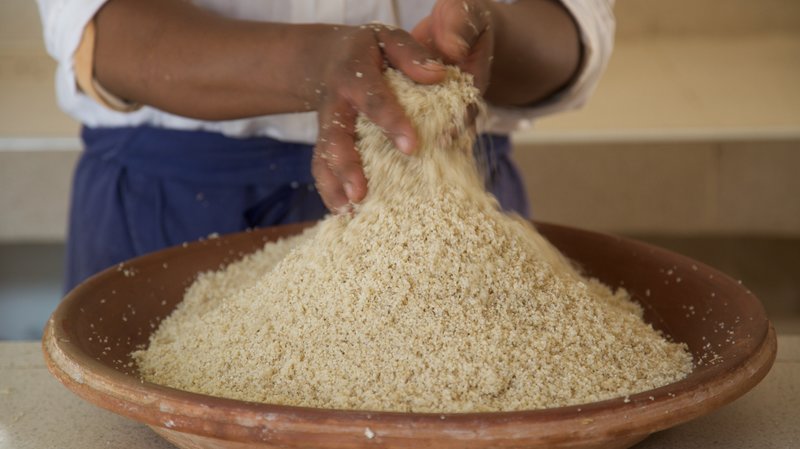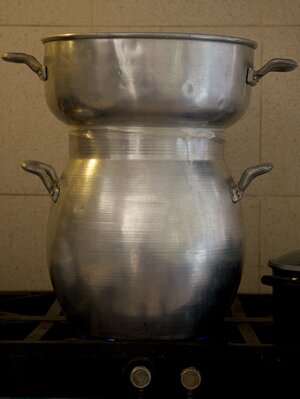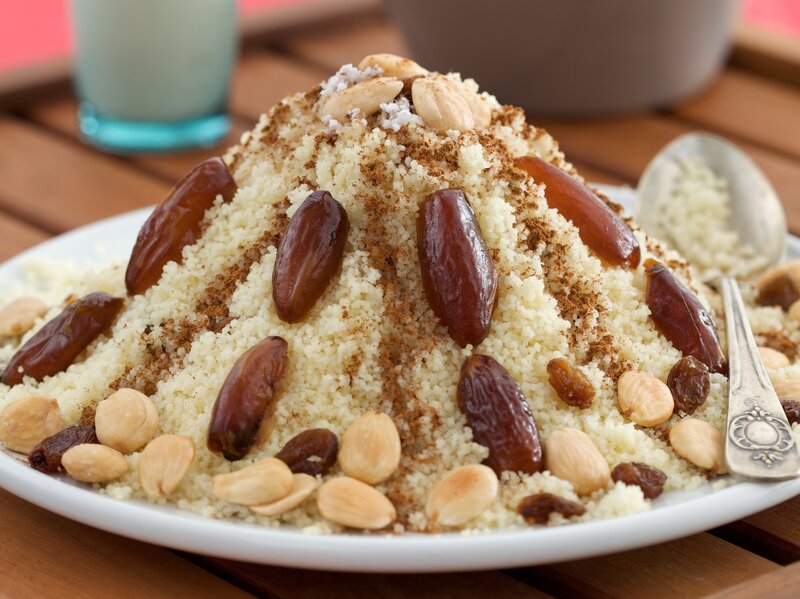
A woman prepares couscous in a small Amazigh (Berber) hamlet on the eastern slopes of Morocco's High Atlas Mountains. (Jeff Koehler for NPR)
In 2016, Algeria announced that it would be applying for UNESCO Intangible Cultural Heritage status for couscous. If successful, the staple food would join a diverse list of more than 500 cultural treasures ranging from hand puppetry in Egypt and tango dancing in Argentina and Uruguay.
Couscous refers to both the tiny, hard granules typically made from crushed hard durum wheat semolina, as well as the dish itself. The tiny balls are steamed in a two-level pot with a perforated steamer basket called kiskis (known in much of the world as a couscoussier) over a stew of meat or fish, vegetables and spices, which is served on top.
While a catalog of outside influences has shaped Algeria's cuisine over the years, it never lost its ancient traditions or uniqueness, wrote Mokhtaria Rezki in her authoritative book Le Couscous Algérian. "Algerian couscous remains in this respect the symbol of our originality and our greatest invention. ... If one had to culinarily and symbolically award a medal of our national cultural identity ... certainly couscous would be the star and the subject." So key is couscous to Algerian culture that some simply refer to it as ta'am, or "food."
Morocco was outraged by Algeria's announcement. Along with Tunisia, it also lays claim to couscous.
But rather than allow intense rivalries to spiral out of control, the UNESCO delegations from Morocco, Algeria, Tunisia and Mauritania worked together to present the U.N. agency with a joint bid in March of 2019.
That required overcoming a history of antagonism. Relations between Morocco and Algeria have been strained since their respective mid-20th century independence from France, and their land border has been closed for the last 25 years. Despite being neighbors and the region's largest economies, Algeria buys less than 1% of Moroccan exports, according to 2017 figures. Morocco and Mauritania fought a war in the Western Sahara from 1975 to 1991, and relations remain tense; Algeria supports the Polisario Front, a rebel national movement fighting for the liberation of the Western Sahara from Morocco.

A double-tiered couscoussier, used to cook couscous. (Jeff Koehler for NPR)
"Our joint bid signals a new era, one of collective awareness and collective action for the safeguarding of our shared intangible cultural heritage," Tunisia's ambassador to UNESCO, Ghazi Gherairi, told NPR. "I hope that this common struggle to protect this culinary tradition of couscous will be another step and a catalyst to work together."
Call it couscous diplomacy.
The Maghreb - the region occupying the northwest half of Africa's crown - is, according to Habib Bourguiba, Tunisia's first president after the country's 1956 independence from France, defined by where people eat couscous: from the Atlantic coast of Morocco, across Algeria and Tunisia, and including western Libya.
That idea played on an older definition of the Maghreb that defined the geographical area by "halq el rouous, akl el couscous, lebs el burnous"- translating to "where men have shaved skulls, wear burnouse, and consume of couscous."
There are regional differences with couscous, but these reside less in the fluffy steamed pellets themselves than in the flavor of hearty stew ladled over top.
In Morocco, the sauce often has complex spice flavorings, blending saffron, ginger, cinnamon, sweet paprika, and turmeric, and sometimes a punch of sweetness from tfaya, a lush caramelized onion and raisin topping. Algerian couscous tends to be more humble and hearty, replete with vegetables (turnips, carrots, zucchini, squashes) and pulses, and seasoned with a relatively limited array of spices. Tunisian couscous has a red broth - from the tomato concentrate liberally stirred into it - and a higher level of spice from the chile-based harissa paste. Lamb is the most popular meat to add to the sauce across the Maghreb. Also popular is beef, and even camel in the southern parts of the Maghreb. Along the coast, many communities prepare it with fish.
While various countries might claim home to the dish, couscous predates such nation states. Most likely it was the Amazigh, the Maghreb's original inhabitants - often referred to as Berber - who began making it, probably using barley and acorn flour, and then, according to James Beard award-winning food historian Clifford A. Wright, from hard (durum) wheat perhaps in the 11th or 12th centuries. Barley couscous remains popular in Amazigh strongholds such as the Atlas Mountains, which stretch more than 1,500 miles across the Maghreb. The name "couscous" comes from the classical Arabic, which is derived from the Amazigh word kseksu.
While no longer eaten on a daily basis as it once was in the Maghreb, it remains a deeply popular and important meal.
"It is the expression of a shared cultural identity among the region of Maghreb in different occasions, such as family gatherings during weekends, marriages, circumcisions, public holidays, religious feasts ..." Gherairi explained. "For years, couscous-preparing knowledge and techniques have been passed from mother to daughter and played an essential role in Maghreb's patriarchal society, as it is an element of a young woman's immaterial dowry. Indeed, women played a key role in transmitting the know-how of couscous. Thanks to our grandmothers and mothers, we have this important 'intangible' heritage preserved until nowadays."

Sweet couscous is popular across the Maghreb. It is generally served with leben, a buttermilk-like fermented drink. (Jeff Koehler for NPR)
The countries of the Maghreb share many things - a way of life, religion, similar Arabic dialects, an original Amazigh population, and a history of conquerors from Phoenicians, Carthaginians, Romans, Arabs, Ottomans (except for Morocco) and French.
Yet it just might be couscous that helps bring a sense of unity and cooperation to the area.
(Libya could not join the bid yet, because it has not ratified the 2003 UNESCO Convention for the Safeguarding of the Intangible Cultural Heritage. If it does so, its name can be added to a successful inscription.)
"The UNESCO bid is not about to solve longstanding regional disputes," said Haim Malka, a senior fellow and deputy director of the Middle East Program at the Center for Strategic and International Studies (CSIS) in Washington, D.C., where he oversees the program'swork on the Maghreb. "What it signals is a growing willingness of leaders to recognize the Maghreb's shared culture, despite political boundaries and conflict. People in Morocco, Algeria and Tunisia are already aware of these bonds, and there is a growing sense of regional identity that is expressed through music, art, and other cultural expressions."
Of these "cultural expressions," it is fitting that the first explored together is food - specifically couscous. "The spirit of sociability and conviviality characterizes this dish of sharing par excellence," said Gherairi. "It translates the bond that strengthens friendships and alliances. It means links, reconciliations, sharing and solidarity."
In December, the UNESCO committee will meet to examine the application. An answer is due in 2020.
How will the delegates celebrate if UNESCO decides in their favor? They will sit down together, said Gherairi. "Around a platter of shared couscous ... for sure." Though what spices go into the topping might still be up for debate.
Jeff Koehler is the author of numerous books, including Where the Wild Coffee Growsand Darjeeling. Follow him on Twitter @koehlercooks or Instagram @jeff_koehler.












